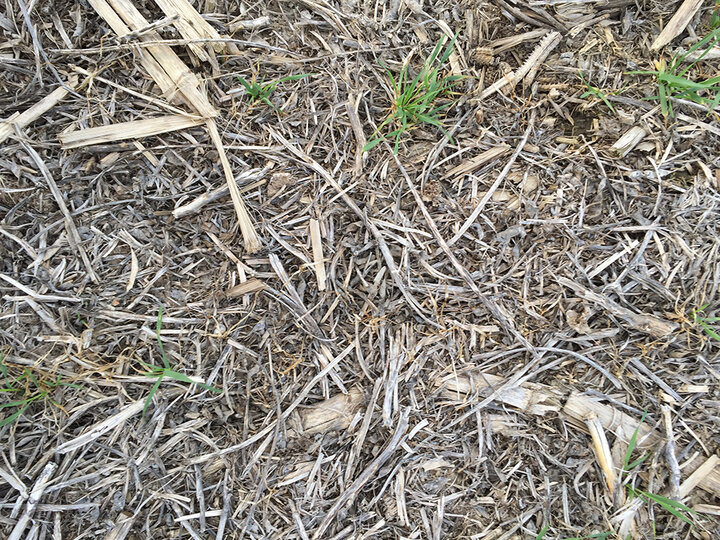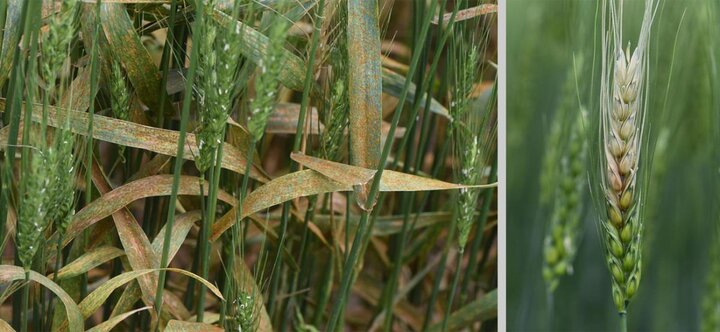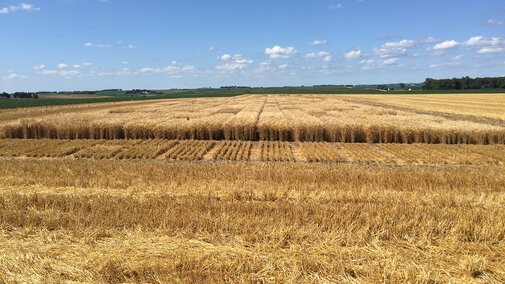No two years are alike in Nebraska and 2019 was definitely unique and challenging for many Nebraska farmers. However, wheat production in eastern Nebraska (Figure 1) ended up decent, given the rough start. Let’s review the 2019 winter wheat growing season:

- Delayed planting due to an extended wet period from the end of September to mid-October
- Cooler and drier than normal November reduced fall tillering and yield potential
- Relatively good temperatures from April through June aided by good soil moisture helped drive yield
- Late onset of foliar diseases was helpful, but wet weather during flowering in May created Fusarium head blight and leaf rust issues
Read last year’s recap of the 2017-18 eastern Nebraska winter wheat crop too at https://cropwatch.unl.edu/2018/eastern-NE-wheat-2018.
Summary of the 2018-19 Growing Season Weather in Eastern Nebraska

It is evident that we experienced large variations and swings in both temperature and precipitation from October through March. However, weather from April through July was relatively good for winter wheat growth and development as a whole.
What is ideal weather for winter wheat in eastern Nebraska?
Though we don’t have a similar analysis conducted in Nebraska, researchers (Romulo, Edwards, and Ochsner, 2017) in Oklahoma and Kansas looked at the interaction between environmental factors and yield for different regions in those states. For east central and eastern Kansas/Oklahoma, wheat yields were improved with the following trends:
- Wetter and warmer-than-normal conditions from planting to flowering
- Cooler-than-normal conditions from flowering through ripening
- Higher solar radiation (more sun) from flowering through ripening
Fall and Winter

Wheat yields this year were generally very good despite late planting caused by wet weather last fall. Fall tillering did not occur in late-planted wheat, but conditions for spring tillering were evidently good enough in many cases. Growers that increased their seeding rate in late October had good plant populations that helped compensate for a lack of fall tillering.
Significant to minor winterkill was observed this year in low residue areas, on tilled ground, shallow-planted spots within fields, and with some varieties (Figure 2). In a few instances, late-planted fields were abandoned or sprayed out due to a combination of winterkill, ponded water/ice, and erosion/deposition from flooding. Fields severely affected by the flooding in some cases were left for cover crop or grazed out, given the shortage of grazeable acres. The extra snow cover during February was important in protecting the wheat since the area experienced well below normal temperatures.
Spring and Summer
In general, weather conditions during April and May were good for wheat. Wheat was taller this year than last year, based on UNL Wheat Variety Trial results. A lack of soil moisture was generally not a limiting factor this spring and early summer, unlike in some areas a year ago (use Drought Monitor Compare Two Weeks tool). With a full soil moisture profile, moderate temperatures during flowering and grain-fill helped compensate for a late planted and later maturing wheat crop in 2019 that finished with little stress.

Earlier in the growing season, prolonged cool temperatures and late snowfall delayed disease onset. The onset of significant disease pressure started during flowering. Stripe rust was confirmed in Saline and Jefferson counties the end of May and in Washington, Saunders, and Dodge counties in early June when wheat was flowering. However, due to the late onset and warmer temperatures that suppress wheat development, stripe rust did not develop to severe, damaging levels.
The three major diseases in eastern Nebraska were Fusarium head blight, leaf rust, and bacterial streak (Figures 3, 4, and 5). All three diseases are favored by moisture and moderate to warm temperatures. These conditions prevailed before, during, and after flowering, causing these diseases to develop to severe levels, especially in fields that were not sprayed to control fusarium head blight and leaf rust. Other diseases that were observed at low levels and mostly in the lower canopy were Septoria tritici blotch, tan spot, and powdery mildew.

Harvest Reports
Wheat growers (n=11) in northeast Nebraska reported yields ranging from 58 to 96 bushels per acre. The average this year would be close to 75 bushels per acres, which is near normal for this area. Fields planted in early October were near the higher end of the yield range, though one field planted on October 31 still obtained a yield of 86 bu/ac. Test weight averaged 60.7 lbs with a range of 56.5 to 62.5 lbs per bushel. Protein ranged from 11.0% to 13.4%, with an average of 12.5%. Varieties planted by these growers included Zenda, SY Wolf, Ruth, WB-Cedar, WB4458, Redfield, and SY Sunrise. Vomitoxin was identified on only a few loads.
Wheat growers (n=11) in southeast Nebraska reported yields ranging from 47 to 96 bushels per acre. The average this year would be close to 65 bushels per acre, which is near normal for this area. Lower yields were often from late-planted fields; however, fields planted as late as mid-November still reached into the 60s (bu/ac). Fields planted in a timely fashion had yields in the 80s (bu/ac) and above. Test weight ranged from 59 to 61 lbs per bushel. Protein ranged from 9.6% to 12.0%. Major dockage from scab/vomitoxin was reported in some loads. Examples of some of the varieties planted by these growers include Ruth, Freeman, Overland, SY Wolf, WB4458, WB-Cedar, and WB-Grainfield.
Reports summarized by the Nebraska Wheat Board on August 12: “Harvest in southeastern Nebraska is complete. Yields ranged from 40-85 bushels per acre. Test weights were lower due to rains at harvest and head blight, producers said. Most test weights averaged 57-60 pounds. Protein levels varied for the region too, with most averaging in the low 10s. Producers estimated head blight in harvested fields ranged from 0-10 percent affected grain.”
| County | Yield (bu/ac) | Test Weight (lbs/bu) | Protein (%) |
|---|---|---|---|
| Clay | 70.9 | 55.1 | 12.8 |
| Jefferson | 100.4 | 58.7 | 12.1 |
| Lancaster | 91.5 | 56.7 | 13.2 |
| Saunders | 64.7 | 56.4 | 12.8 |
| Washington | 106.1 | 59.5 | 13.3 |
The results from variety trials conducted by the UNL Department of Agronomy and Horticulture are posted online. Additional multi-year and location analysis will be conducted and made available in the near future. Growers are encouraged to consider multi-site and multi-year performance when selecting wheat varieties. A summary of the yield, test weight, and protein across varieties is shown in Table 2. Growers need to consider that the highest yielding variety may not generate the most revenue per acre once varietal differences in test weight and protein are accounted for.
If you’d like to learn more about wheat production in eastern Nebraska, check out these CropWatch articles written this past season:
- June 28, 2019: Why Did Fusarium Head Blight Develop in My Wheat Field after I Sprayed at Flowering?
- June 14, 2019: Wheat Disease Update: Fusarium Head Blight
- June 7, 2019: Wheat Update: Diseases Are Increasing
- May 31, 2019: Stripe Rust Confirmed in Nebraska Wheat
- May 24, 2019: Wheat Disease Update
- May 17, 2019: Levels of Wheat Diseases Low, But Likely to Increase
- May 3, 2019: Eastern Nebraska Winter Wheat Update
- September 27, 2018: Winter Wheat Varieties with an Eastern Nebraska Fit

